(Mark Paricio is a PolarTREC Teacher accompanying the Polaris Project this summer. To read all of Mark’s journals, go to: http://www.polartrec.com/expeditions/siberian-arctic-systems-study )
Pleistocene Park
What was it like to live in the time of the mammoths? How was the environment different then? What animals lived then, and what was their ecosystem like?
It’s hard to go back in time (really hard!), but perhaps creating that environment is not out of the question.
This is the vision and experiment of Sergey Zimov, founder of the Northeast Science Station, and founder of Pleistocene Park, an hour’s boat trip south of the science station.
Our Journey to the Land of the Mammoths – Without any Mammoths
The Russian permafrost drilling team that I have been helping, asked me to come to help them put in the first bore hole in Pleistocene Park so they could start monitoring the permafrost temperatures in the area. After loading our boats to capacity with drilling equipment and people sitting on drilling equipment, Max Holmes and Sergey Zimov piloted us up the river to Pleistocene Park.
I had the unique pleasure of walking around the Park with Max and Sergei when we arrived. This is an expansive area they have painstakingly fenced over the last many years. Sergey’s real goal is to create the grass as it was during the last glacial period when mammoths and large herds of mammals roamed to see the effect of the animals on the environment. This area, although very cold, did not become ice bound during that time – possibly due to the effects of the animals. So he has placed musk oxen, bison, elk, and horses on the land with various degrees of success.
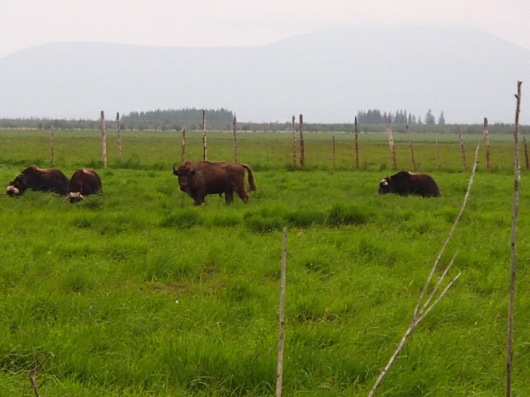
Musk oxen and a bison at Pleistocene Park. The musk oxen were rambunctious, smacking heads, even drawing blood.
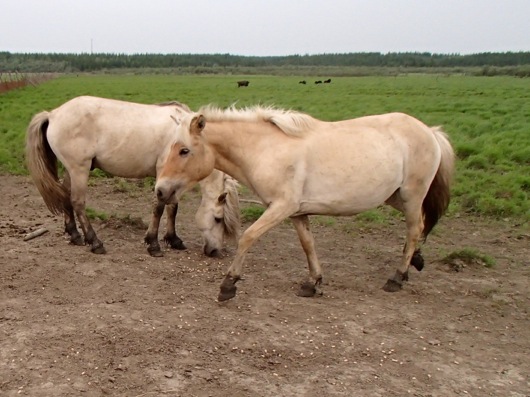
Wild horses getting a dietary supplement. It would be a big mistake to get any closer!
So what do you do if you can’t get a mammoth to roam in your park? I know in Kenya, we followed elephant trails through the bamboo forests, as did the other animals. They are incredible bulldozers of trees and shrubs, capable of creating grasslands on their own if they (literally) set their heads to it. To imitate their ecological niche, Pleistocene Park uses an 8-wheel drive Argo all-terrain vehicle, capable of knocking down shrubs and small trees, and creating pathways.
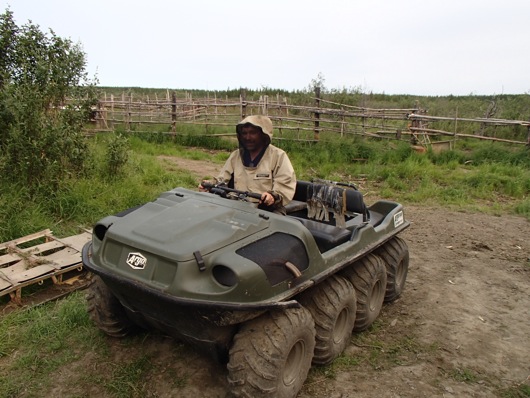
The 8-wheel drive Argo imitates the ecological niche of a mammoth – and is a kick to drive!
Out of curiosity, I followed one of the pathways through thick willows and was surprised by how it made the area passable. I was not the only follower of these trails, as demonstrated by the soft musk oxen hair I found on the willows.
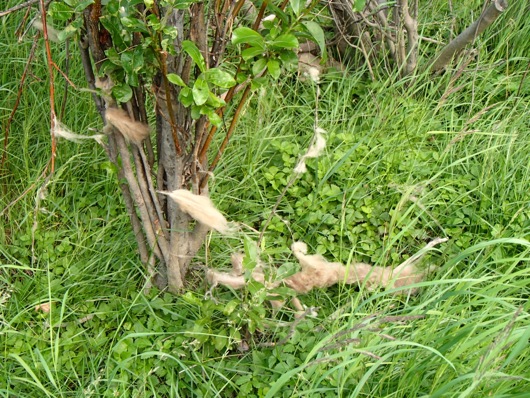
Incredibly soft musk oxen fur left behind in the willows.
Additionally, they have cleared some treed areas for grazing from the taiga. As grass respires more than shrubs, this has the effect of drying the wetlands out – a definite ecological difference.
The Permafrost Tunnel
In addition to his interest in Pleistocene ecology, Sergey also has recently had his workers dig a permafrost tunnel at the Park. I estimate it extends downward about 5-6 meters in depth, penetrates into the hill about 15 meters, and is nearly 2 meters tall. This was a great place to store frozen foods (like moose meat and fish) and frozen borehole cores. The temperature of the cave was measured by Dr. Sasha Kholodov, our drilling specialist, to be -6.97°C (about 20 °F).
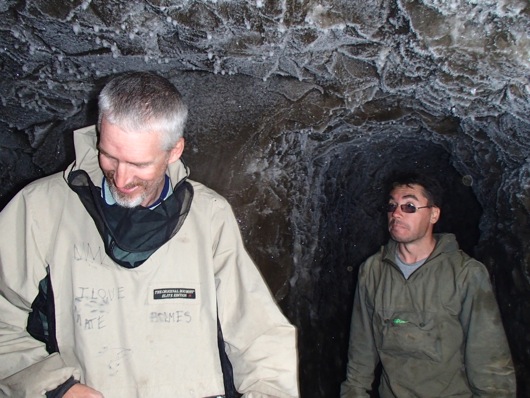
Max Holmes and Sasha Kholodov amazed by their tour of the permafrost tunnel.
I have found Sergey’s vision of Pleistocene park to be a fascinating experiment requiring imagination well beyond my own. Who knows, maybe somebody will find a way to replace the Argo with a real mammoth some day.
Stay curious my friends! – Mark Paricio




Comments(3)-
-
-
James Burnham says
April 20, 2013 at 9:05 pmI think this is a wonderful idea, notwithstanding all the “issues” that have been raised. I wish it luck. I would love to be physically associated with the park, especially regards the wisent or bison, but alas, I’m 54, no relevant training and I have a wife and son to take care of. I will dream about it though.
Nick says
September 4, 2013 at 5:53 pmThat looks so cool. I hope that more progress is being made about this and I hope that I could witness this in person one day. I wish I could do something to help out but it’s cool. Keep up the good work, gentlemen.
Night-Gaunt49 says
July 9, 2016 at 2:46 amI am all for bringing back extinct species. Not just from the Pleistocene, but the past 20,000 years when humans have been busy killing off dozens of species from the giant birds of New Zealand and Australia to the passenger pigeon in the USA.